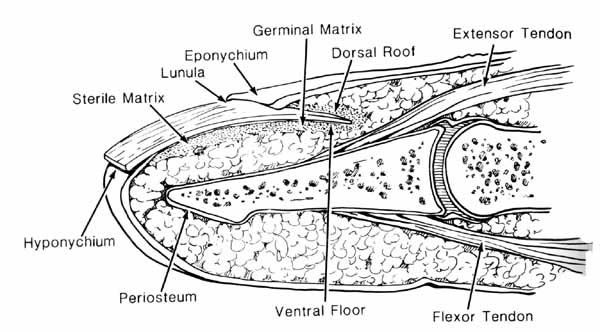Fingertip Crush Injuries
Introduction
The fingertip is a highly specialized structure, with many specialized features. It has a lot of nerves, as I am sure you are more aware of than you would like! The illustration below shows many of the important structures of the fingertip.

The fingernail itself, the thing that you cut with a fingernail clipper, is called the nail plate. Underneath the nail plate is the nail bed, the mostly pink tissue you can see under the nail. It has several regions. The proximal (this is a medical term that is good to understand, it means that part closer to the heart; the opposite direction is called distal) part of the nail plate is called the germinal matrix. This is the part of the nail bed that originates the nail plate. When you look at your fingertip, part of the germinal matrix can be seen through the nail plate: it is the white moon-shaped area. The name for this is the lunula. That is, the lunula is the visible part of the germinal matrix. The majority of the germinal matrix is not visible, and it is located under the proximal nail fold, or eponychium. The cells of the dorsal roof in the eponychium are responsible for placing the shine on your nail plate. The hyponychium is a specialized structure uner the nail plate at the distal end. Its purpose is to help prevent dirt and bacteria from entering under the nail into the nail bed. It is backed by specialized capillaries (small arteries) and lymphatics that also help to prevent the invasion of bacteria or funger under the nail plate. The fingertip is also an organ of temperature regulation: if you are hot, special valves open up to allow increase bloodflow to your fingertips. If you are cold, these valves shut off (this explains why your fingertips get so cold in cold weather!) The fingertip is a very specialized structure!
Fingertip Crush Injuries
There are many kinds of fingertip injuries, from crushed fingertips (hit with a hammer, smashed in the car door, and other things that are just too painful to think about!) to cuts all the way to various levels of amputation. This page will only discuss crush injuries, not fingertip amputations.
The nail bed can bleed, which creates a collection of blood (called a hematoma) under the nail plate. This is called a subungual hematoma. They can be very painful, and need to be drained. This usually dramatically decreases the pain of a fingertip injury. Fractures of the fingertip, usually of the type called a tuft fracture, usually heal well if given a chance to rest. A splint and rest is all that is needed.
If the nail's germinal matrix is crushed or otherwise injured, the nail plate may separate from the germinal matrix. This is usually not a problem. What will happen is a new nail plate will form, and it will eventually push off the old nail plate. You don't need to do anything, just protect the old nail plate from ripping off (it even sounds painful!) by covering it with a bandaid. Trim off whatever you can trim easily, so there will be less to catch. Give it time. It usually takes about three months for the new nail to come in completely.
A crushed fingertip will always be swollen and painful. Keep your hand elevated and take both an anti-inflammatory (such as aspirin or Motrin, if you can take such medication) and Tylenol. These work in different ways and it is a case of 1 + 1 = 3. Ice will be very helpful for the first day or three. Be sure to take both an anti-inflammatory and tylenol.
The fingertip will usually stay a little bit swollen permanently, but it should not interfere with function. It will take longer than you think is reasonable, about six to twelve months, for the swelling to go down as much as it will.
Keep your dressing dry. Moisture will promote a bacterial infection. Use a plastic bag when you shower. If you get it wet, you will need to change the dressing.
I hope that this information helps you understand and take care of your fingertip crush, and supplements the explanation I gave you in the office.
